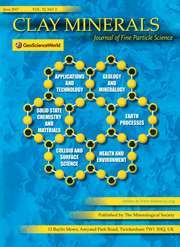Article contents
Some problems connected with the retention of ions by clay constituents
Published online by Cambridge University Press: 14 March 2018
Extract
Clay minerals possess the peculiar characteristic that they normally occur as very small crystals. We cannot, therefore, afford to ignore the contribution that colloid science can make to the study of clay minerals. Many colloidal systems are stable because the particles are electrically charged. There is, of course, electrical neutrality of the system as a whole, but there is an electric separation within the system whereby electricity of one kind (it may be a positive or negative, depending on the system) is anchored for the time being to the particles while the complementary charge exists as ions (counter ions they are often called). Some of the counter ions must be regarded as in solution in the suspending medium (normally water) for it is their mobility relative to the particles which gives rise to electrical conductivity and to electrophoresis, electro-endosmosis and streaming potential.
- Type
- Research Article
- Information
- Copyright
- Copyright © The Mineralogical Society of Great Britain and Ireland 1947
- 1
- Cited by


